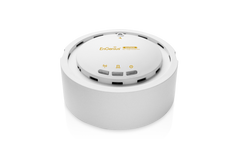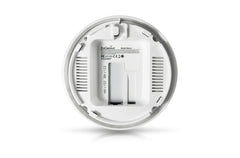SUBSCRIBE TO OUR NEWSLETTER
Get the latest updates on new products and upcoming sales






High-Powered, Long-Range Ceiling Mount, Wireless N300 Indoor Access Point
Extends the Network Further
EAP300
Features
High-Powered, Long-Range Wireless-N Connectivity
Up to 29dBm RF Tx power provides 2x greater signal coverage compared to other competitive offerings.
6x Speed Over Legacy 802.11g Access Points

Compliant with 802.11b/g/n standard and MIMO delivering up to 300 Mbps throughput over wireless for greater overall performance and connectivity.
SSID-to-VLAN Tagging
Can be configured to broadcast up to four (4) SSIDs. Each SSID can be tagged to a specified company network VLAN for different user access based on established access rights.
Power-over-Ethernet Option

Supports Power-over-Ethernet (IEEE 802.3af) and enables deployment in ceilings and other areas where power outlets may not be available. Recommended PoE Injector: EnGenius EPE5818af (802.3af compliant) option (purchased separately).
Monitor and Manage Several Access Points from the Convenience of Your Desk
EZ Controller™ software for Windows, Mac OS X or Linux provides a suite of tools for IT managers, installers and network administrators to manage and maintain wireless networks. Available as a free download.
Technical Specifications
Hardware
RF: 2.4 GHz Frequency Band
Standard: IEEE 802.11b/g/n
IEEE 802.11b/g: 2.400~2.484 GHz
Data Rate: Up to 300 Mbps
Memory: 32MB
Flash Memory: 4MB
Power Consumption: Up to 4W
Antenna
Internal 5 dBi Omni-Directional Antenna (diversity support)
Physical Interface
1 x RJ-45 Fast Ethernet (10/100 Mbps)
1 x Reset Button
Power Jack
LEDs Status
Power
LAN (10/100 Mbps)
WLAN (Wireless Connection)
Power Requirements
Power Supply: 90 to 240 VDC ± 10%, 50/60 Hz
(depends on different countries)
Active Ethernet (Power-over-Ethernet, IEEE 802.3af)
Power Adapter (United States) 48VDC/0.375A
Device: 12V/1A
Modulations
OFDM: BPSK, QPSK, 16-QAM, 64-QAM, DBPSK, DQPSK, CCK
Operating Channels
2.4 GHz: US/Canada 1-11
Receiver Sensitivity
802.11b (2.412~2.472 GHz) best ≤ -98 dBm
802.11g (2.412~2.472 GHz) best ≤ -93 dBm
802.11n (2.412~2.472 GHz) best ≤ -93 dBm
Available Transmit Power
(Max. Power may be different depending on local regulations)
802.11b (2.412~2.472 GHz)
29 dBm @ 1~11 Mbps
802.11g (2.412~2.472 GHz)
29 dBm @ 6 Mbps
29 dBm @ 9 Mbps
28 dBm @ 12 Mbps
28 dBm @ 18 Mbps
24 dBm @ 24 Mbps
24 dBm @ 36 Mbps
23 dBm @ 48 Mbps
23 dBm @ 54 Mbps
802.11n (2.412~2.472 GHz)
26 dBm @ MCS0/MCS8
26 dBm @ MCS1/MCS9
25 dBm @ MCS2/MCS10
25 dBm @ MCS3/MCS11
24 dBm @ MCS4/MCS12
24 dBm @ MCS5/MCS13
23 dBm @ MCS6/MCS14
23 dBm @ MCS7/MCS15
Software
Topology
Infrastructure/Ad-Hoc
Operation Modes
Access Point, WDS Bridge, WDS Access Point, Universal Repeater
Multiple BSSID
Supports up to 8 BSSIDs per radio
LAN
IP (check validity and DHCP server IP range)
DHCP Server
DHCP range, lease time, client list
SSID-to-VLAN Tagging
Supports 802.1q SSID-to-VLAN tagging
Spanning Tree
Supports 802.1d Spanning Tree Protocol
Wireless
Wireless Mode: 11b/11g/11n
Channel selection (settings vary by country)
Channel bandwidth (Auto, 20 MHz, 40 MHz)
Transmission rate:
2.4 GHz: 11n only, 11b/g/n mix, 11b only, 11b/g, 11g only
QoS
WMM (Wireless Multimedia)
VPN
Pass-through (PPTP, L2TP, IPSec)
WPS
Software only
Management
Tx Power Control
Adjust transmit power by dBm
Configuration
Web-based configuration (http)/Telnet
Telnet Server
CLI
Firmware Upgrade
Via web browser, settings are reserved after upgrade
Administrator Setting
Administrator Username and Password Change
Reset Setting
Reboot (press 1 second).
Reset to factory default (press 10 seconds)
System Monitoring
Status Statistic and Event Log
SNMP
V1, V2c
MIB
MIB I, MIB II (RFC1213) and private MIB
Traffic Measurement
Per interface
Auto-channel Selection
Automatically selecting least congested channel
Bandwidth Measurement
IP range and bandwidth management
Backup and Restore
Save and restore settings through Web interface
Diagnosis
IP pinging statistics
Wireless / Network
PPPoE: Point-to-Point Protocol over Ethernet in Client Router mode
(this function will keep trying when failed or disconnected)
PPTP: Point-to-Point Tunneling Protocol (PPTP) is a method for implementing virtual private networks
Wireless Security
WPA/WPA2 Personal (WPA-PSK using TKIP or AES)
WPA/WPA2 Enterprise (WPA-EAP using TKIP)
802.1X RADIUS Authenticator: MD5/TLS/TTLS, PEAP
SSID broadcast enable/disable
MAC Address Filtering, Up to 50 fields
L2 Isolation (Access Point mode)
Wireless STA (Client) connected list (Idle/Connection Time, Pkt statistics)
Environmental & Physical
Temperature Range
Operating: 0º to 50ºC (32º to 122ºF)
Storage: -20ºC to 60ºC (-4Fº to 140ºF)
Humidity (non-condensing)
Operating: 90% or less
Storage: 90% or less
Certifications
FCC, IC
Maximum data rates are based on IEEE 802.11 standards. Actual throughput and range may vary depending on many factors including environmental conditions, distance between devices, radio interference in the operating environment, and mix of devices in the network. Features and specifications subject to change without notice. Trademarks and registered trademarks are the property of their respective owners. For United States of America: Copyright ©2013 EnGenius Technologies, Inc. All rights reserved.
Dimensions and Weights
EAP300 Device
Weight: 0.62 lbs.
Diameter: 4.73”
Height: 1.97”
Get the latest updates on new products and upcoming sales
Thanks for subscribing!
This email has been registered!